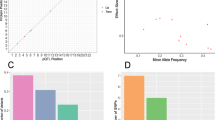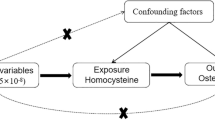Abstract
Summary
Dickkopf-related protein 1 (DKK1) is a major inhibitor of Wnt signalling pathway but also plays an important role in bone formation. Its circulating levels appear to correlate significantly with plasma levels of inflammatory factors, fractalkine and IL-6. This study, using a large sample of UK twins, showed that the variation of each of these factors and correlation between them was explained by the genetic factors, and indicated possible association with DKK1 gene variants.
Introduction
DKK1 is involved in the development of several inflammatory conditions related to bone and joint degradation. Our objectives were to explore the genetic contribution (heritability) to circulating DKK1 variation and its correlation with other inflammatory cytokines, interleukin 6 (IL-6) and fractalkine, and to test whether the DKK1 heritability could be attributable to single nucleotide polymorphisms (SNPs) mapped to DKK1, IL-6 and FRCT genes.
Methods
The study included a large community-based sample of 4939 women drawn from the general UK population. Plasma samples were analysed for circulating levels of DKK1, IL-6 and fractalkine (FRCT); 65 SNPs of DKK1, IL-6 and FRCT candidate genes, with MAF >0.1, were examined. We applied variance component analysis to evaluate contribution of putative genetic (including above SNPs) and environmental factors to variation of DKK1, and its correlation with IL-6 and FRCT.
Results
Putative genetic factors explained 42.2 ± 2 % of the total variation of circulating DKK1 levels, and were also significant for fractalkine and IL-6 variations. Most importantly, we report significant phenotypic (0.208 ± 0.006–0.459 ± 0.007) and genetic (0.338 ± 0.069–0.617 ± 0.033) correlations between these molecules. We found evidence suggestive of association between the DKK1 and its structural genes variants.
Conclusions
Circulating DKK1 levels correlated significantly with levels of IL-6 and FRCT, known risk factors for several inflammatory processes suggesting a potential role of DKK1 in inflammation and tissue injury. Our results suggest the contribution of genetic factors in inter-individual variation of DKK1 levels in human population. However, further studies are required to determine genetic polymorphisms affecting DKK1 variation and its correlation with IL-6 and FRCT.


Similar content being viewed by others
Abbreviations
- APO_A1:
-
Apo lipoprotein A1, g/l
- APO_B:
-
Apo lipoprotein B, g/l
- BMD-T:
-
Bone mineral density total, kg
- BMI:
-
Body mass index, kg/m2
- CVD:
-
Cardiovascular disease
- DKK1:
-
Dickkopf-related protein 1
- DM:
-
Diabetes mellitus
- DZ:
-
Dizygotic twin
- ELISA:
-
Enzyme-linked immunosorbent assay
- FBM:
-
Fat body mass, kg/m2
- FRCT:
-
Fractalkine, pg/ml
- HDL:
-
High-density lipoprotein, mmol/l
- IL-6:
-
Interleukin 6, pg/ml
- LBM:
-
Lean body mass, kg/m2
- LDL:
-
Low-density lipoprotein, mmol/l
- LRP:
-
Lipoprotein-related receptor
- MZ:
-
Monozygotic twin
- TG:
-
Triglycerides mmol/l
- VAD :
-
Variance attributable to additive genetic effects
- VEN :
-
Variance attributable to random environmental effects
- VTW :
-
Variance attributable to environmental effects shared by twins
References
Katoh Y, Katoh M (2005) Comparative genomics on DKK2 and DKK4 orthologs. Int J Mol Med 16:477–481
Ogoshi K, Kasamatsu A, Iyoda M, Sakuma K, Yamatoji M, Sakamoto Y, Ogawara K, Shiiba M, Tanzawa H, Uzawa K (2011) Dickkopf-1 in human oral cancer. Int J Oncol 39:329–336
Hampson G, Edwards S, Conroy S, Blake GM, Fogelman I, Frost ML (2013) The relationship between inhibitors of the Wnt signalling pathway (Dickkopf-1 (DKK1) and sclerostin), bone mineral density, vascular calcification and arterial stiffness in post-menopausal women. Bone 56:42–47
Butler JS, Murray DW, Hurson CJ, O'Brien J, Doran PP, O'Byrne JM (2011) The role of DKK1 in bone mass regulation: correlating serum DKK1 expression with bone mineral density. J Orthop Res 29:414–418
Hardy R, Juarez M, Naylor A, Tu J, Rabbitt EH, Filer A, Stewart PM, Buckley CD, Raza K, Cooper MS (2012) Synovial DKK1 expression is regulated by local glucocorticoid metabolism in inflammatory arthritis. Arthritis Res Ther 14:R226
Han SX, Zhou X, Sui X, He CC, Cai MJ, Ma JL, Zhang YY, Zhou CY, Ma CX, Varela-Ramirez A, Zhu Q (2015) Serum dickkopf-1 is a novel serological biomarker for the diagnosis and prognosis of pancreatic cancer. Oncotarget 6:19907–19917
Kim KI, Park KU, Chun EJ, Choi SI, Cho YS, Youn TJ, Cho GY, Chae IH, Song J, Choi DJ, Kim CH (2011) A novel biomarker of coronary atherosclerosis: serum DKK1 concentration correlates with coronary artery calcification and atherosclerotic plaques. J Korean Med Sci 26:1178–1184
Garcia-Martin A, Reyes-Garcia R, Garcia-Fontana B, Morales-Santana S, Coto-Montes A, Muñoz-Garach M, Rozas-Moreno P, Muñoz-Torres M (2014) Relationship of Dickkopf1 (DKK1) with cardiovascular disease and bone metabolism in Caucasian type 2 diabetes mellitus. PLoS One 9:e111703
Krabben A, Huizinga TW, Mil AH (2015) Biomarkers for radiographic progression in rheumatoid arthritis. Curr Pharm Des 21:147–169
Hsing CH, Wang JJ (2015) Clinical implication of perioperative inflammatory cytokine alteration. Acta Anaesthesiol Taiwan 53:23–28
Van Snick J (1990) Interleukin-6: an overview. Annu Rev Immunol 8:253–278
Kishimoto T (2006) Interleukin-6: discovery of a pleiotropic cytokine. Arthritis Res Ther 8(Suppl 2):S2
Czerny B, Kaminski A, Kurzawski M, Kotrych D, Safranow K, Dziedziejko V, Bohatyrewicz A, Pawlik A (2010) The association of IL-1beta, IL-2, and IL-6 gene polymorphisms with bone mineral density and osteoporosis in postmenopausal women. Eur J Obstet Gynecol Reprod Biol 149:82–85
Moura KF, Haidar M, Bonduki C, Feldner PC Jr, Silva I, Soares JM Jr, Girão MJ (2014) Frequencies of interleukin-6, GST and progesterone receptor gene polymorphisms in postmenopausal women with low bone mineral density. Sao Paulo Med J 132:36–40
Ota N, Hunt SC, Nakajima T, Suzuki T, Hosoi T, Orimo H, Shirai Y, Emi M (1999) Linkage of interleukin 6 locus to human osteopenia by sibling pair analysis. Hum Genet 105:253–257
Livshits G, Ermakov S, Vilker A (2010) Outlines of the biochemistry of osteoarthritis. Curr Rheumatol Rev 6:234–250
Zlotnik A, Yoshie O (2000) Chemokines: a new classification system and their role in immunity. Immunity 12:121–127
D'Haese JG, Demir IE, Friess H, Ceyhan GO (2010) Fractalkine/CX3CR1: why a single chemokine-receptor duo bears a major and unique therapeutic potential. Expert Opin Ther Targets 14:207–219
Koch AE (2005) Chemokines and their receptors in rheumatoid arthritis: future targets? Arthritis Rheum 52:710–721
Leonov A, Trofimov S, Ermakov S, Livshits G (2011) Quantitative genetic study of amphiregulin and fractalkine circulating levels–potential markers of arthropathies. Osteoarthritis Cartilage 19:737–742
White GE, Greaves DR (2012) Fractalkine: a survivor's guide: chemokines as antiapoptotic mediators. Arterioscler Thromb Vasc Biol 32:589–594
Livshits G (2005) Genetic epidemiology of skeletal system aging in apparently healthy human population. Mech Ageing Dev 126:269–279
Su S, Snieder H, Miller AH, Ritchie J, Bremner JD, Goldberg J, Dai J, Jones L, Murrah NV, Zhao J, Vaccarino V (2008) Genetic and environmental influences on systemic markers of inflammation in middle-aged male twins. Atherosclerosis 200:213–220
Franco L, Williams FM, Trofimov S, Surdulescu G, Spector TD, Livshits G (2013) Contribution of putative genetic factors and candidate gene variants to inter-individual variation of circulating fractalkine (CX3CL1) levels in a large UK twins' sample. Hum Immunol 74:358–363
Wu SH, Neale MC, Acton AJ Jr, Considine RV, Krasnow RE, Reed T, Dai J (2014) Genetic and environmental influences on the prospective correlation between systemic inflammation and coronary heart disease death in male twins. Arterioscler Thromb Vasc Biol 34:2168–2174
Kuipers AL, Yu S, Kammerer CM, Nestlerode CS, Bunker CH, Patrick AL, Wheeler VW, Zhang Y, Zmuda JM (2015) Heritability and genetics of serum dickkopf 1 levels in African ancestry families. Calcif Tissue Int 96:155–159
Spector TD, Williams FM (2006) The UK adult twin registry (Twins UK). Twin Res Hum Genet 9:899–906
Arden NK, Spector TD (1997) Genetic influences on muscle strength, lean body mass, and bone mineral density: a twin study. J Bone Miner Res 12:2076–2081
Maston GA, Evans SK, Green MR (2006) Transcriptional regulatory elements in the human genome. Annu Rev Genomics Hum Genet 7:29–59
Heintzman ND, Ren B (2009) Finding distal regulatory elements in the human genome. Curr Opin Genet Dev 19:541–549
Malkin I, Ginsburg E (2014) Program package for pedigree analysis (version MAN-2009). Department of Anatomy and Anthropology, Sackler Faculty of Medicine, Tel Aviv University. Technical Report, Israel
Falconer D (1996) Introduction to Quantitative Genetics, 4th edn. Longman, London
Korostishevsky M, Cohen Z, Malkin I, Ermakov S, Yarenchuk O, Livshits G (2010) Morphological and biochemical features of obesity are associated with mineralization genes' polymorphisms. Int J Obes (Lond) 34:1308–1318
Dovjak P, Dorfer S, Föger-Samwald U, Kudlacek S, Marculescu R, Pietschmann P (2014) Serum levels of sclerostin and dickkopf-1: effects of age, gender and fracture status. Gerontology 60:493–501
Polyzos SA, Anastasilakis AD, Bratengeier C, Woloszczuk W, Papatheodorou A, Terpos E (2012) Serum sclerostin levels positively correlate with lumbar spinal bone mineral density in postmenopausal women—the six-month effect of risedronate and teriparatide. Osteoporos Int 23:1171–1176
Register TC, Hruska KA, Divers J, Bowden DW, Palmer ND, Carr JJ, Wagenknecht LE, Hightower RC, Xu J, Smith SC, Dietzen DJ, Langefeld CD, Freedman BI (2013) Plasma Dickkopf1 (DKK1) concentrations negatively associate with atherosclerotic calcified plaque in African-Americans with type 2 diabetes. J Clin Endocrinol Metab 98:E60–E65
Dimitri P, Wales JK, Bishop N (2011) Adipokines, bone-derived factors and bone turnover in obese children; evidence for altered fat-bone signalling resulting in reduced bone mass. Bone 48:189–196
Viardot A, Heilbronn LK, Samocha-Bonet D, Mackay F, Campbell LV, Samaras K (2012) Obesity is associated with activated and insulin resistant immune cells. Diabetes Metab Res Rev 28:447–454
Kuipers AL, Zhang Y, Yu S, Kammerer CM, Nestlerode CS, Chu Y, Bunker CH, Patrick AL, Wheeler VW, Miljkovic I, Zmuda JM (2014) Relative influence of heritability, environment and genetics on serum sclerostin. Osteoporos Int 25:905–912
Bonnet N, Biver E, Durosier C, Chevalley T, Rizzoli R, Ferrari S (2015) Additive genetic effects on circulating periostin contribute to the heritability of bone microstructure. J Clin Endocrinol Metab 100:E1014–E1021
Garcia-Alvarez M, Berenguer J, Guzmán-Fulgencio M, Micheloud D, Catalán P, Munoz-Fernandez MA, Alvarez E, Resino S (2011) High plasma fractalkine (CX3CL1) levels are associated with severe liver disease in HIV/HCV co-infected patients with HCV genotype 1. Cytokine 54:244–248
Ferroni P, Riondino S, Vazzana N, Santoro N, Guadagni F, Davi G (2012) Biomarkers of platelet activation in acute coronary syndromes. Thromb Haemost 108:1109–1123
Ueland T, Otterdal K, Lekva T, Halvorsen B, Gabrielsen A, Sandberg WJ, Paulsson-Berne G, Pedersen TM, Folkersen L, Gullestad L, Oie E, Hansson GK, Aukrust P (2009) Dickkopf-1 enhances inflammatory interaction between platelets and endothelial cells and shows increased expression in atherosclerosis. Arterioscler Thromb Vasc Biol 29:1228–1234
Santilli F, Paloscia L, Liani R, Di Nicola M, Di Marco M, Lattanzio S, La Barba S, Pascale S, Mascellanti M, Davì G (2014) Circulating myeloid-related protein-8/14 is related to thromboxane-dependent platelet activation in patients with acute coronary syndrome, with and without ongoing low-dose aspirin treatment. J Am Heart Assoc 3:e000903
Franco L, Williams FM, Trofimov S, Surdulescu G, Spector T, Livshits G (2013) Elevated plasma fractalkine levels are associated with higher levels of IL-6, Apo-B, LDL-C and insulin, but not with body composition in a large female twin sample. Metabolism 62:1081–1087
Acknowledgments
The present study was supported by the Israel Science Foundation (grant number #1018/13) to GL. FW is supported by Arthritis Research UK.
TwinsUK. The study was funded by the Wellcome Trust; European Community’s Seventh Framework Programme (FP7/2007-2013). The study also receives support from the National Institute for Health Research (NIHR)-funded BioResource, Clinical Research Facility and Biomedical Research Centre based at Guy’s and St Thomas’ NHS Foundation Trust in partnership with King’s College London. SNP Genotyping was performed by The Wellcome Trust Sanger Institute and National Eye Institute via NIH/CIDR.
Author information
Authors and Affiliations
Corresponding author
Ethics declarations
Conflicts of interest
None
Electronic supplementary material
Below is the link to the electronic supplementary material.
ESM 1
(DOC 512 kb)
Rights and permissions
About this article
Cite this article
Prakash, J., Williams, F.M., Trofimov, S. et al. Quantitative genetics of circulating Dickkopf-related protein 1 (DKK1) in community-based sample of UK twins. Osteoporos Int 27, 2065–2075 (2016). https://doi.org/10.1007/s00198-016-3486-x
Received:
Accepted:
Published:
Issue Date:
DOI: https://doi.org/10.1007/s00198-016-3486-x




